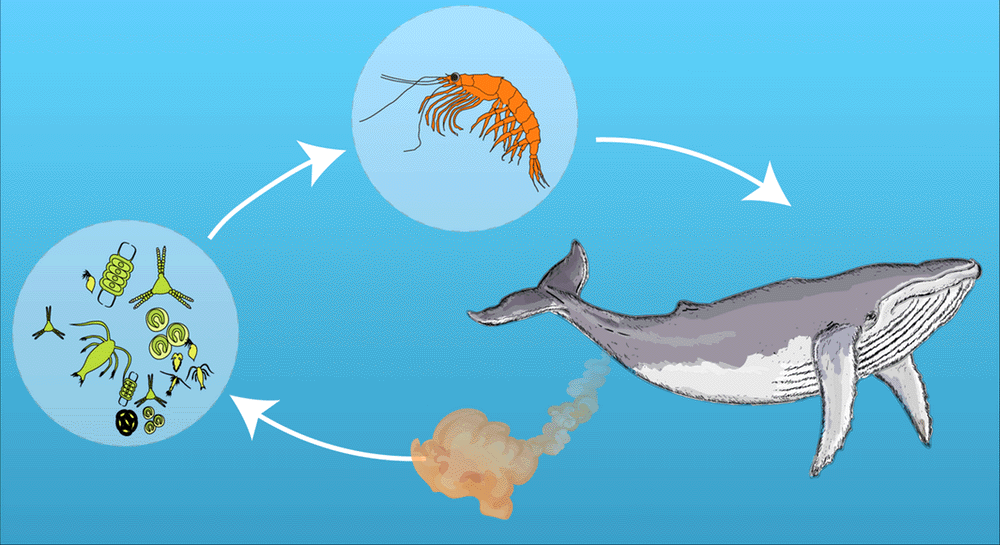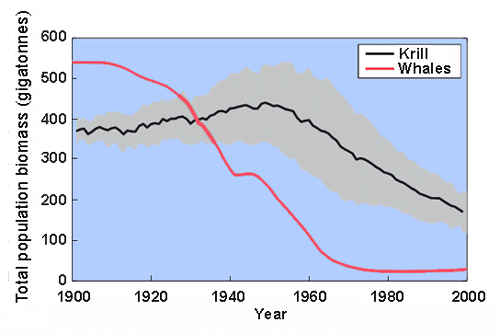Krill Paradox: More Whales, More Plankton, More Krill, More Fish.
Whales are not simply a major consumer of krill and fish, but play a critical role in sustaining the very krill
and fish populations upon which they feed.
The Importance of Krill on the Food Chain
Krill are small crustaceans that look similar to shrimp and feed on phytoplankton and to a lesser extent
zooplankton.
Krill are a vitally important link in the global food chain and are the main staple diet of hundreds of different
animals including fish, whales, seals, penguins, albatrosses, petrels, squid and many others. Krill are the basis of
the food web in the Southern Ocean around Antarctica and most marine species depend on krill for their survival.
Krill are among the species with the largest total biomass, estimated at around 400 million tonnes. Their daily
vertical migration provides food for surface feeders at night and in deeper waters during the day.
The Krill Paradox
Next to man, whales are the largest consumer of small fish and krill. When millions of whales were removed from
the ocean by commercial whaling, a huge increase in small fish and krill was expected. But the opposite happened.
The loss of whales from the ecosystem caused a substantial loss in the volumes of krill and the fish that feed on
them. This contradiction to seemingly valid reasoning became known as the "krill paradox".

The symbiotic loop relationship between whales, phytoplankton and krill
The scientific evidence shows that whales increase (not decrease) the volumes of krill by enhancing their
phytoplankton food source through faecal fertilisation. This is reported for the largest consumer of krill, the
blue whale and the right whale
(approximately 411 remaining) both currently endangered due to commercial whaling.

Population Biomass: Whales - versus - Krill
Whales are not simply a major consumer of krill and fish, but play a critical role in sustaining the very krill
and fish populations upon which they feed.
Simply put: more whales = more nutrients = more phytoplankton = more small fish and krill.
A paper entitled Whales maintained a high abundance of krill; both are ecosystem engineers in the Southern Ocean
shows the symbiotic relationship between whales and krill. This is shown in the graph left. The millions of whales
killed due to commercial whaling resulted in a substantial decline in krill abundance.
More information about the krill paradox and how whales help the health of our oceans and atmosphere can be
found here and at the Great Whales
Conservancy.
Krill and Whales Under Threat
According to the U.S. National Oceanic and Atmospheric Administration, Antarctic krill populations have dropped
an estimated 80 percent since the 1970s. Precisely why, scientists have not conclusively determined, but loss of sea
ice due to ocean warming and commercial whaling is thought to be major factors.
LiveScience reports that the populations of large whales are estimated to have fallen to between 1% and
34% of their pre-whaling levels. Accordingly, in the North Atlantic Ocean, the nutrient transport ability of
whales is 14% of its historical value. In the North Pacific Ocean, just 10% and in the Southern Ocean, a paltry 2%.
More detailed information on the Global Nutrient Transport in a World of Giants can be found here.
The Importance of Krill - As a Carbon Sink
According to a 2017 study by the British Antarctic Survey, krill play an important role in the transport of carbon
within the oceans. Their movement between different depths can accelerate how atmospheric carbon moves into the deep
ocean and can have a major impact on the world's climate.
A 2014
report by the International Union for the Conservation of Nature shows that krill take up 23,000,000 tonnes of
carbon each year. That's equivalent to the weight of 15.2 million cars per year. (1.5 tonnes of carbon is equivalent
by weight to a large family car). 5 years later, this figure had more than doubled to 35 million cars, as shown in a
report published in March 2019 by Ocean Unite.
Peto's Paradox
Another paradox associated with whales and other large mammals is Peto's Paradox. This 2019 study describes how whales
defy the cancer odds: Good genes. This research was also reported in Medical News Today.















